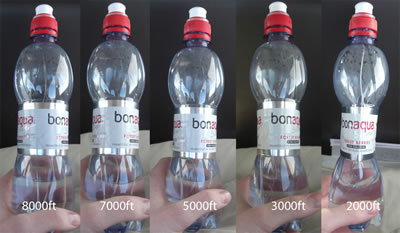Most of the time, air feels like it is weightless, even though it is composed of molecules that have mass. Since Earth’s gravity influences everything on Earth that has mass, air also has weight. We usually don’t notice the weight of the atmosphere pressing down on us because our bodies have evolved in its presence.
For example, we have evolved to use air pressure in order to breathe. When you inhale, muscles in your abdomen make your chest cavity larger. This makes the air pressure inside your chest lower than the air pressure outside it. To equalize the pressure, air enters your body, filling your lungs. When your chest cavity becomes smaller, the air pressure inside it increases and air leaves your lungs in order to create a state of equilibrium between the air pressure inside and outside of your body.
While you can learn how to control your breathing consciously, most of the time people aren’t aware of their breathing. Your body automatically takes advantage of the air pressure around you to make sure you get enough oxygen. Life would be much more difficult if, in addition to all the other things you have to remember, you had to remember to breathe to stay alive. (In fact, victims of a disease known as Congenital Central Hypoventilation Syndrome, or Ondine’s Curse, stop breathing when they are asleep and unconscious. They often die in infancy; however, artificial respirators can help keep them alive. Cetaceans – whales, dolphins and porpoises – have to remember to breathe. As they live underwater, they have to know, consciously, that they must come to the surface to take a breath of air. When the right side of a cetacean’s brain is awake, the left side is asleep, and vice versa. This way some part of the brain is always awake and aware of the need to breathe.)
Sometimes, however, changes in air pressure are noticeable. You might develop an earache when you are on a plane that is descending toward the Earth, or even when you are descending very quickly in an elevator in a tall building. This is because the air pressure inside and outside of your ear are no longer evenly balanced.
You will also find that when preparing a recipe, you will have to boil food longer when you are at a high altitude than when you are at sea level. This is because atmospheric pressure is lower at higher altitudes. Water boils faster when the air pressure is low; therefore, it boils at a lower temperature at higher altitudes.
Here are some experiments that demonstrate the power of air pressure:
Using Air Pressure to Crush a Bottle
Equipment Needed
Water
A gas or electric burner
A bottle with a screw-on lid
The Experiment
Pour half of a cup of water into the bottle. Leave the lid off.
Place the bottle on the burner
As soon as you see steam coming from the bottle, remove it from the burner. (Use a potholder to avoid burning yourself.)
Screw the lid tightly onto the bottle.
As the bottle cools, you will see its sides beginning to show signs of strain.
By the time the bottle has cooled down completely, the sides will have buckled inwards.
This happens because boiling the water creates water vapor, which pushes air out of the bottle.
When you screw the lid back on the bottle, you prevent the air from reentering the bottle as it cools.
As the bottle cools, the steam trapped inside the bottle condenses into water, lowering the air pressure inside the bottle. The greater pressure of the air outside the bottle causes the sides of the bottle to bend inward.
Using Air Pressure to Blow Up a Balloon
This experiment will show you how you can use suction to create a change in air pressure that will blow up a balloon.
Equipment Needed
1 balloon
1 rubber band
2 glass tubes
Jar with tightly fitting cork
Tool for drilling holes in cork
The Experiment
Use the rubber band to fasten an uninflated balloon to the end of one of the glass tubes.
Remove the cork from the jar.
Drill two holes through the cork, each large enough for a glass tube to fit through.
Place one glass tube in each hole
Replace the cork on the bottle, making sure the seal is airtight.
The tubes should now be inside the bottle, with the uninflated balloon also inside the bottle.
Place the end of the tube without the balloon in your mouth and suck in air.
The balloon will expand.
This works because when you suck air out of the jar to via the tube without the balloon, you lower the air pressure in the jar. To equalize the pressure inside and outside of the jar, air enters through the tube with the balloon.
Creating a Vacuum in a Radish
This experiment will show how you can create a vacuum using a radish.
Equipment Needed
1 Knife
1 Radish
1 Dish
The Experiment
Cut a large, firm radish in half with a single stroke of the knife
Use the point of the knife to scoop out some of the flesh of the radish in the half with the long root.
Air will fill up the empty space in the radish.
Now press that half of the radish firmly into the center of a clean saucer.
This will cause the air to rush out of the radish, creating a vacuum in the center of the radish.
This will create an airtight seal between the radish and the dish.
The radish will stick so tightly to the saucer that when you lift the radish, the dish will be lifted up with it.
